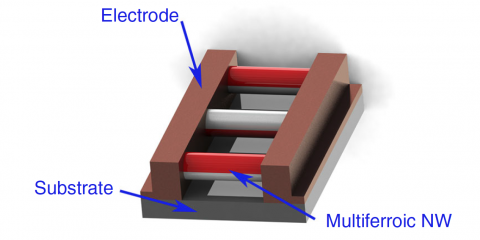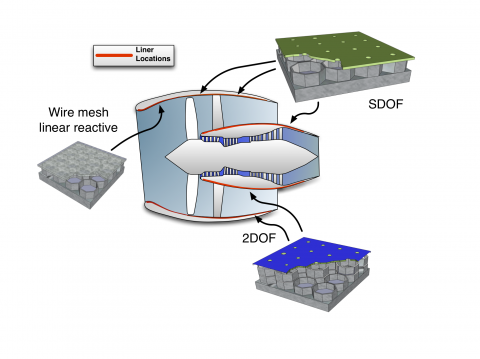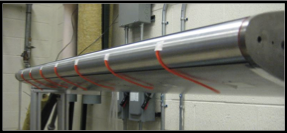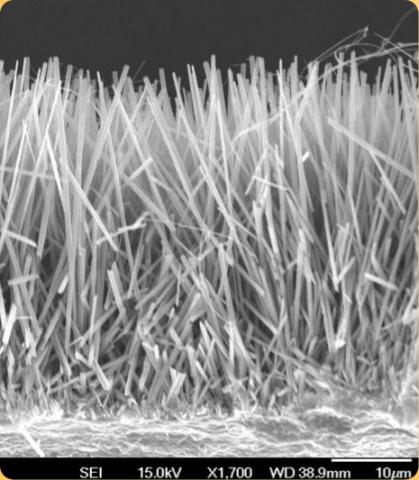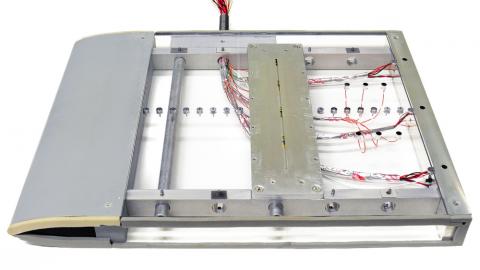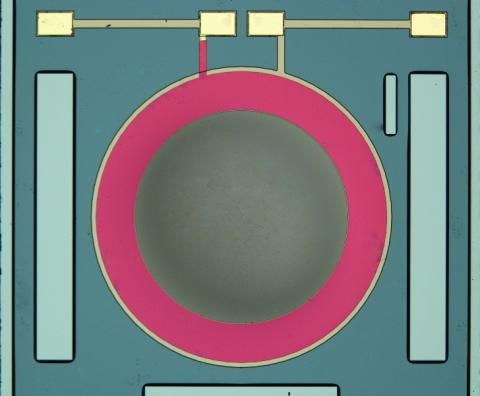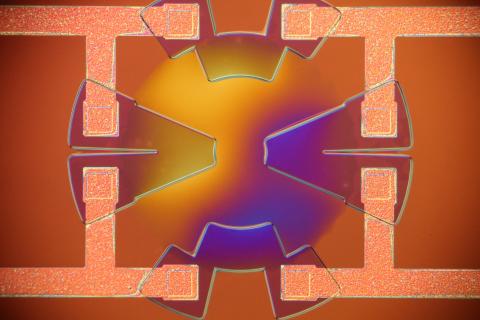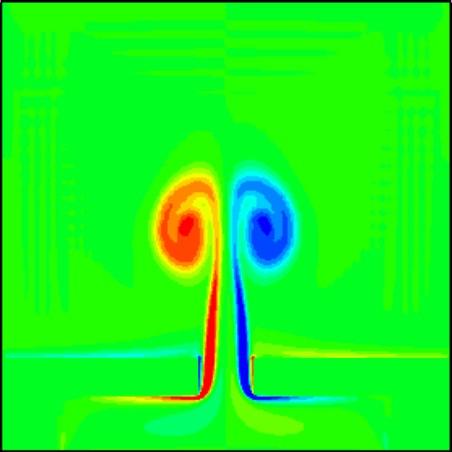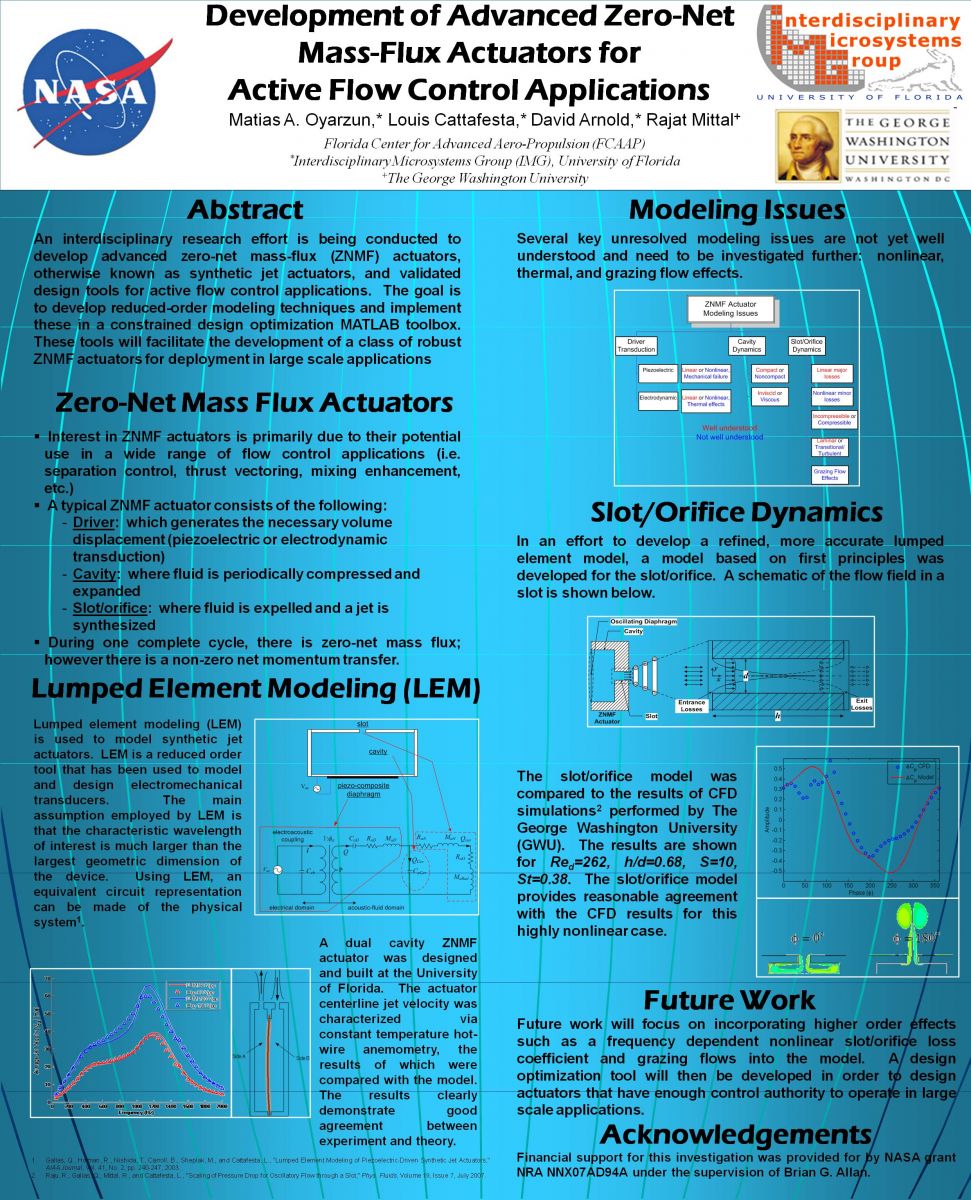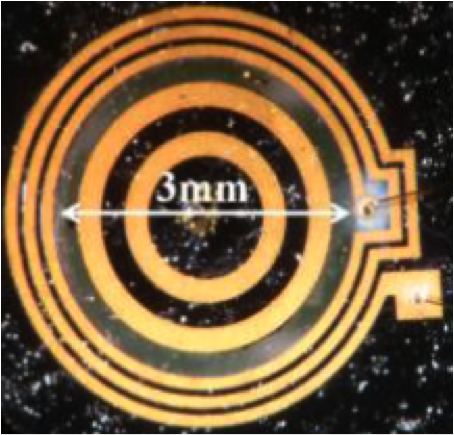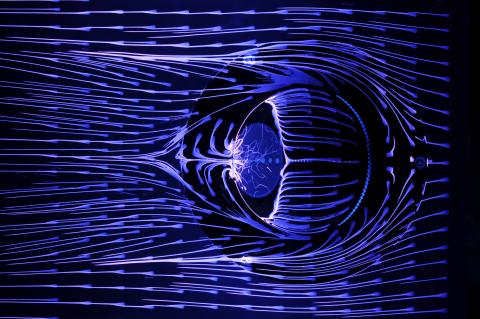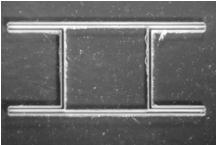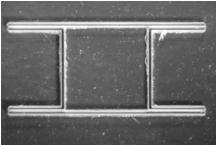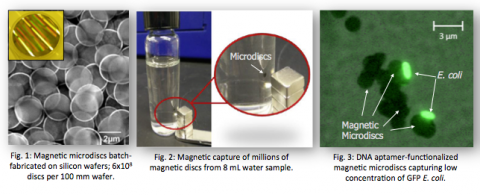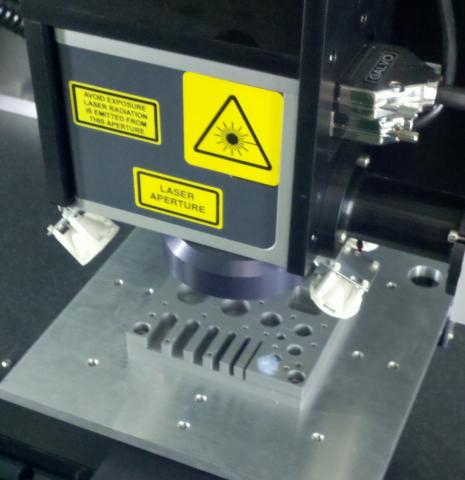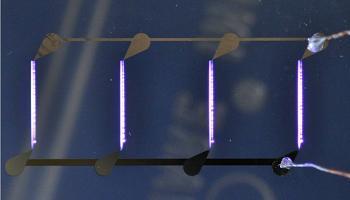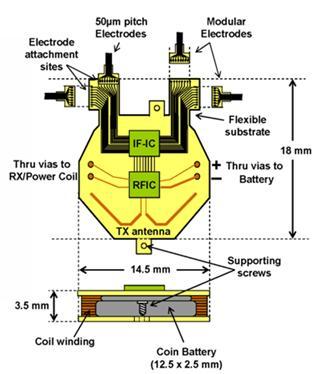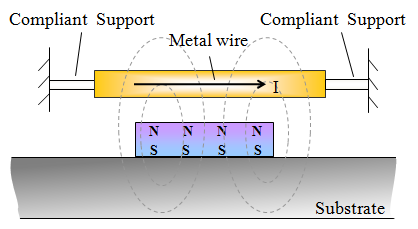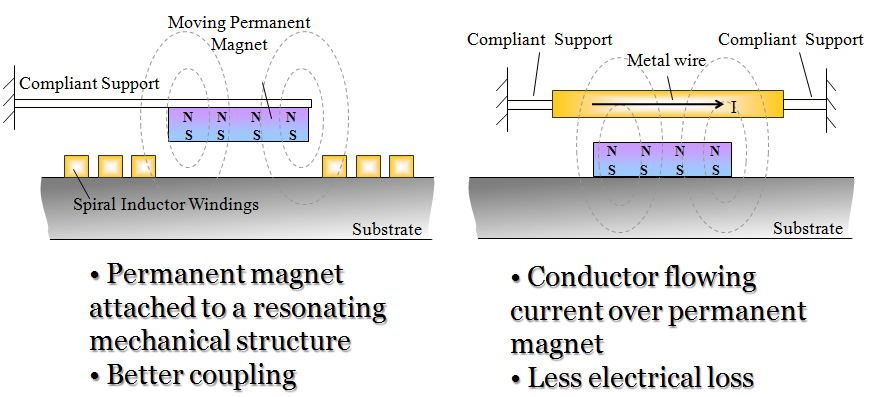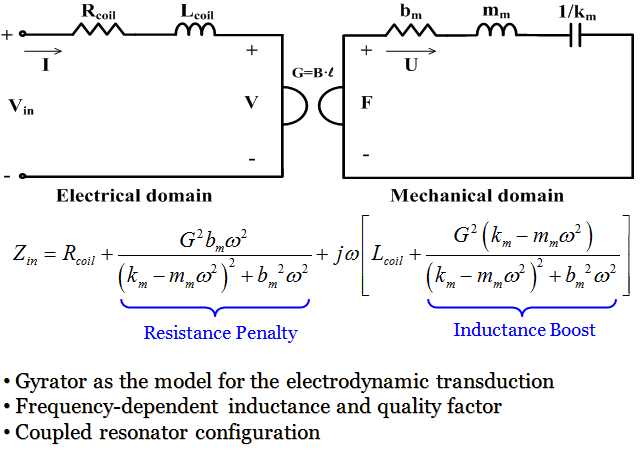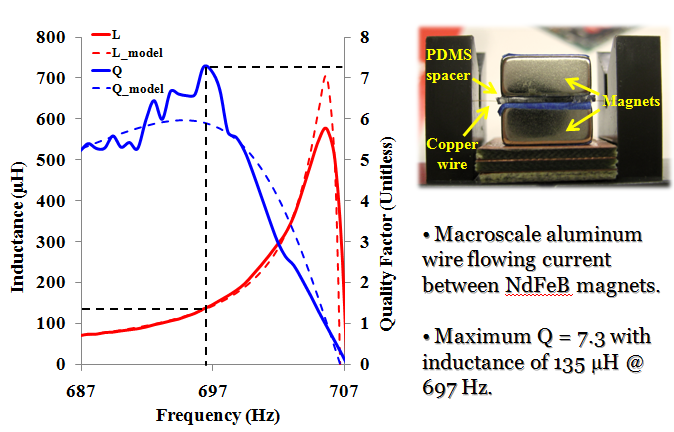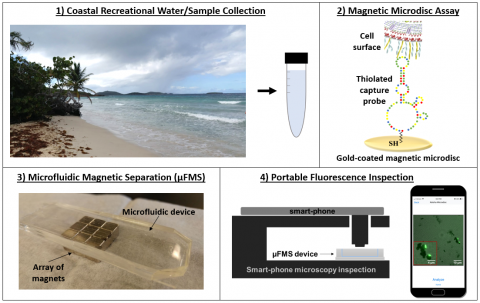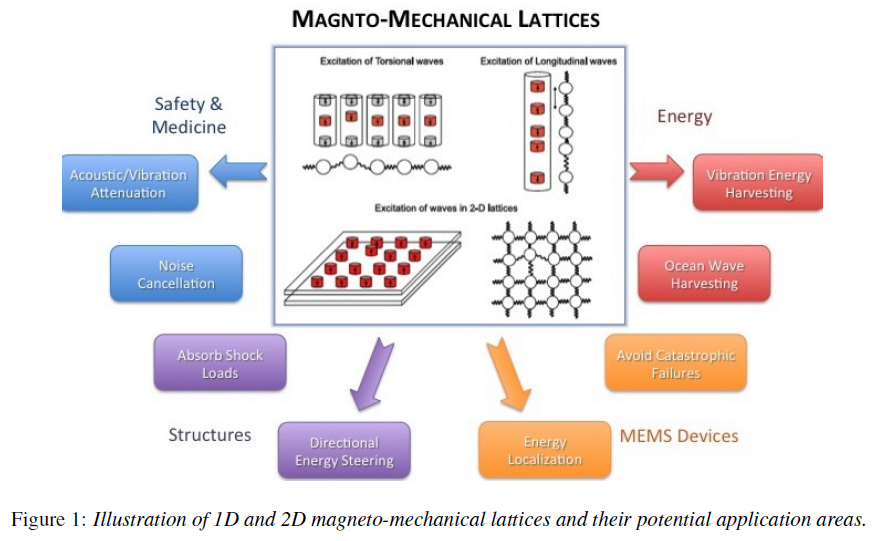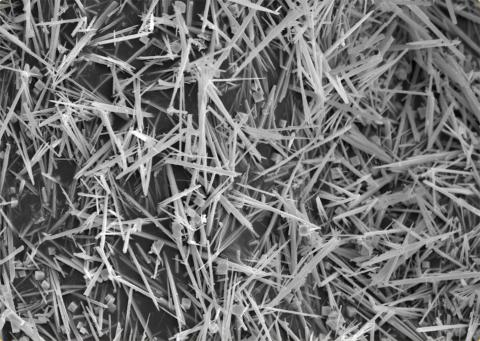Projects
Primary tabs
Electromagnetics and Photonics
The objective of the effort is to design a compact Bluetooth/UWB antenna design with 5GHz WLAN notchi function.
Motivation
Among short-range wireless communication systems, Ultra-wideband (UWB) technology, with a frequency allocation of 3.1-10.6 GHz, has gained a lot of popularity from researchers and the wireless industry alike due to the high data transfer rate (110-200 Mb/s) and low power consumption. However, since UWB covers the frequency spectrum of Wireless Local Area Network (WLAN) operating at 5.2 GHz (5150-5350 MHz) and 5.8 GHz (5725-5825MHz), a frequency notched function in the UWB antenna design is greatly desirable to avoid interferences from WLAN. Since 2002, various antenna structures and methods to notch a specific frequency band have been introduced. Moreover, a planar integrated antenna working on both Bluetooth and UWB has been recently introduced for systems operating in those two communication systems.
Objectives
(1) UWB antenna design
(2) 5GHz frequency notch function
(3) Integrate Bluetooth antenna
The objective of the effort is to design a high gain circular polarization antenna using metamaterial slabs for satellite communication.
Motivation
Mordern satellite communication systems often demand low-profile, wide bandwidth, high gain and circular polarization antennas. Traditionally, a reflector antenna, a horn antenna, and a microstrip array antenna are widely used to achieve high gain circular polarization. Recently, a metamaterial approach has been emerged as a promising method for a high gain antenna. However, a high gain circular polarization antenna using metamaterial remains as a big challenge.
Objectives
(1) High gain antenna with metamaterial slabs
(2) Circular polarization for satellite communication systems
This goal of this research and development program is to enable revolutionary advances aimed at providing high resolution imaging through even the worst material environments. The proposed effort utilizes standard ELF-VLF signals of opportunity (VLF transmitter signals and lightning-generated sferics) to provide background imaging capabilities and enhances the background 3-D resolution space by simultaneously leveraging the frequency dependent magnetic transparency properties of highly conducting media. The IMG-related portion of the effort focuses on creating efficient rotating magnets, used to create oscillating static magnetic fields that scatter from conducting media only when the frequency of oscillation is above a corner frequency set by the electrical properties and the thickness of the conductor. The overall effect is a frequency selective transparency that enables imagers to better discern between two adjacent conducting bodies of different thicknesses.
Research Objective
To investigate the use of advanced microfabrication technologies and MEMS-enabled magnetization methods in developing reduced-scale permanent magnet undulator structures (with fine pole pitch ~5 microns) while maintaining reasonable magnetic field strengths as well as efficient generation of brilliant, high energy (>10keV) mono-energetic x-rays from modest electron beam source energies (~200MeV).
Theory
An accelerated beam of electrons with relativistic velocities experiences an undulation when passing through a spatially periodic magnetic field. This undulation of the beam trajectory results in the generation of electromagnetic radiation from which intense, tunable x-rays can be produced.
Portable and wearable electronics require wireless charging to sustain mobile usage at convenient positions and locations. The goal is to develop a compact, highly power efficient wireless power transfer charging system operating at 6.78 MHz, which is compliant with the Rezence standard.The research scope includes development of a highly compact, high efficiency, ferrite-core receiver antenna; and a metamaterial lens to enhance WPT efficiency between the transmitter and the receiver. In this work, we focus on WPT receiver modules for various portable and wearable consumable electronics with a power rating of ~10 W such as smart phones, radios, laptops, tablets, and military electronics. In future work, this technology could also be scalable to other power ranges, such as mW for biomedical implants to kW for automobiles.
High density passive components (inductors, transformers, capacitors) are developed and integrated with high frequency (100-500 MHz) CMOS switching power conversion circuits. The mm3-scale integrated converter will be capable of delivering >20 V from a battery source to enable mobile microsystems such as micro air vehicles and microrobots.
High-inductance-density air core inductors and transformers have been fabricated using a three-dimensional copper electroforming process. These devices have measured inductance densities > 100 nH/mm2 and quality factors > 20. Optimal performance is achieved in the range of 50 MHz - 500 MHz to enable next generation switching converters operating at very high frequencies.
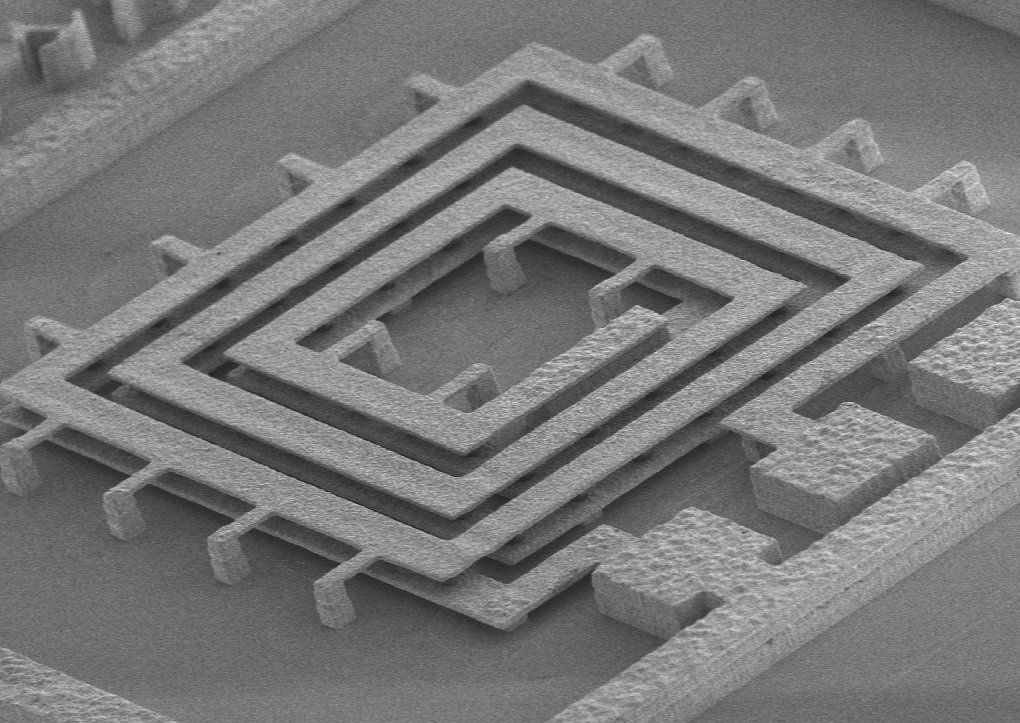
Research Objectives
To develop a wireless shear-stress sensor array to provide three-dimensional, time-resolved, fluctuating skin friction data to aid turbulence model development.
Approach
Each sensor is effectively an LC tank made up of a variable-capacitance floating element and an integrated inductor. The sensing antenna is inductively coupled to the tank and can detect a change in the resonant frequency caused by a displacement of the floating element. An array is realized by designing each sensor to have it’s own unique resonant frequency. Then a single broad spectrum antenna can monitor the entire array.
Broader Impact
The realization of such an array will enable fundamental scientific studies of complex turbulent flows. It could also be implemented into a feedback control system for future air vehicles employing active flow control.
We seek to develop a platform that allows magnetic field sensing using a small footprint, in the absence of an external power supply. Our approach uses magnetoelectric nanofibers to create a zero-power magnetic field sensor. The challenge is to develop methods to assemble these materials into devices that leverage their unique anisotropic properties.
The figure of merit for magnetoelectric materials is the magnetoelectric coefficient, a measure of the amount of voltage generated with respect to the magnitude of the applied magnetic field. Bulk magnetoelectrics and thin films are limited by defects and substrate clamping respectively. To overcome the limitations of thin-film based composite magnetoelectrics we have developed magnetoelectric bilayer structures on a single nanofiber, i.e., 1D magnetoelectrics. These materials are theoretically predicted to have magnetoelectric coupling coefficients that are orders of magnitude greater than their thin film counterparts.
Magnetoelectric materials can be employed in a wide variety of applications including magnetic field sensors and tunable resonance energy harvesters. By optimizing for material system and architecture, drastic increases in magnitude of voltage generated with decreased size can be achieved. This could allow for more sensitive magnetic field sensors appropriate for a wider array of applications and decreased size to allow for easier integration into ICs.
Acoustics and Fluid Mechanics
In their effort to locate, understand and mitigate the impact of noise sources on an aircraft, aeroacousticiansare in need of a high performance, low cost microphone to combat the increasing noise restrictions on commercial aircraft. Existing commercial sensors, even with their relatively high cost, in some cases constrain the quality and type of measurement that may be achieved. One such constraint is that the physical size and characteristics of the sensors limit the optimal locations in which the sensors may be placed. Previous generations of MEMS aeroacoustic microphones have failed to address the need for a sensor that can be packaged and installed with a smooth front surface to be used for boundary layer measurements in a fuselage array at cruise conditions. Additionally, these microphones must meet demanding requirements, including the sensing of high sound pressure levels (>160 dB) with low distortion (<3%) and high sensitivity stability (with respect to moisture and freezing) over temperatures from -60°F to 150°F. This work addresses the limitations of existing MEMS piezoelectric microphones used in aeroacoustic applications by incorporating through-silicon vias(TSVs) into the fabrication to eliminate the use of wirebondsthat affect the flow field and create an overall flush-mount microphone package.
.png)
Acoustic liners remain the standard for providing a method to reduce environmental noise from aircraft engine nacelles. To aid in their development, facilities are required that are capable of accurately educing the acoustic impedance in the presence of mean flow. The Grazing Impedance Tube at NASA LaRC possesses these capabilities and was donated to the University of Florida. Improvements have been made to enable optical flow diagnostics, provide an increased speed range, and reduce turbulence levels. This facility provides a testbed to improve upon current liner impedance eduction methods as well as facilitate development of novel design approaches and studies into fundamental liner flow physics.
| Metric | Value |
| Dimensions | 2" x 2" |
|
Maximum Mach Number |
0.6 |
| Maximum SPL |
130 dB @ Ma = 0.5 |
Detailed aeroacoustic and fluid dynamic experiments are being conducted on a 0.52 m chord 2-D dual-slotted circulation control (CC) airfoil in the University of Florida Aeroacoustic Flow Facility (UFAFF). The results from this study will be used to compare with theory and computational studies and will provide guidance to enable the design of a CC system with reduced noise. To date, the investigation has focused on farfield microphone measurements and detailed particle image velocimetry (PIV) measurements of the flowfield.
Experimental and numerical results over the past decade have conclusively demonstrated the effectiveness of turbulent drag reduction (up to 40%) through near-wall control schemes such as oscillating walls and traveling waves. However, these promising results have yet to lead to a suitable surface for practical application. We are developing a new near-wall turbulence control technique based on a recently developed nanowire surface, composed of vertically aligned Barium Titanate (BaTiO3) nanowires. Since BaTiO3 is a highly coupled piezoceramic, the surface can be manipulated by application of an electric field; and conversely the surface generates an electric potential in response to an applied mechanical load. We have hypothesized that actuation of the nanowire surface can produce cross-stream motion that will alter the structure of the boundary layer over the nanowire surface, resulting in modification of the wall shear stress. This hypothesis is based on recently improved understanding of the correlation between low-speed streak instability and the generation of drag-inducing streamwise vortices; suppressing these vortices at their onset by transverse motion controls within the viscous sublayer has proven extremely effective at stabilizing the low-speed streaks, leading to significant drag reduction.
A detailed study of the effect of blowing from a rounded wing tip on the attenuation of wing tip vortices generated by a NACA0012 semi-span airfoil is being conducted in two wind tunnels at IMG. The first, the UF Closed Circuit Wind Tunnel, will be used for measuring lift and drag of the airfoil and characterizing the wing tip flowfield using one or more flow measurement techniques such as particle image velocimetry, laser Doppler velocimetry and a fast-response Cobra probe. The second facility, the UF Aeroacoustic Flow Facility (UFAFF), is an open jet test section wind tunnel inside an anechoic chamber that will be primarily used to characterize the acoustics of the airfoil with far-field microphones and phased acoustic arrays. Lift and drag will also be measured in the UFAFF to determine the effect, if any, of the differing wind tunnel configurations on aerodynamic performance.
A series of aerodynamic and acoustic wind tunnel experiments are being performed on a 1/4-scale high fidelity replica of a Gulfstream G550 aircraft nose landing gear at the University of Florida Aeroacoustic Flow Facility (UFAFF). Experiments consist of the analysis of model surface pressure measurements and flowfield velocity via laser Doppler velocimetry (LDV), noise source localization maps via beamforming using a large-aperture microphone array, and the determination of far-field noise level spectra using a linear array of free-field microphones. The objective of this study is to determine the mechanisms of nose landing gear noise and to explore potential noise reduction schemes.
LDV Techniques:
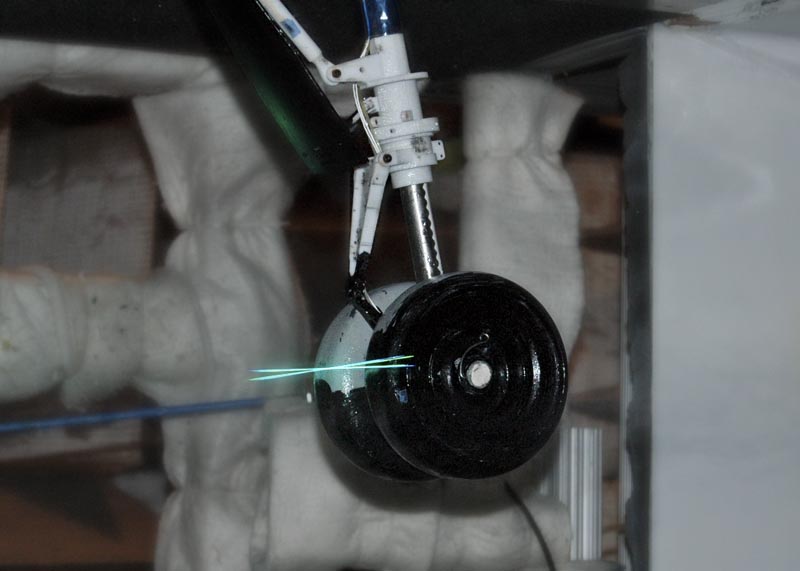
Illuminated LDV probe volume downstream of nose
landing gear
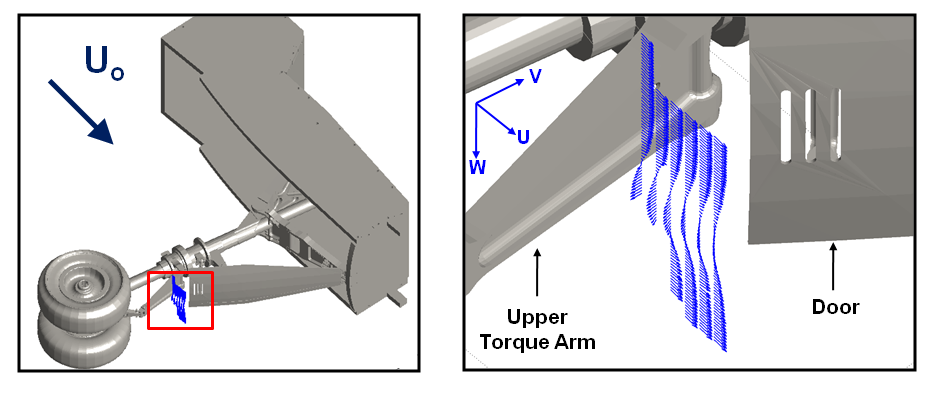
Isometric view of nose gear model. Close-up view of wake velocity profile.
Noise Source Identification Techniques:
.png)
Beamforming testing configuration within the UFAFF.
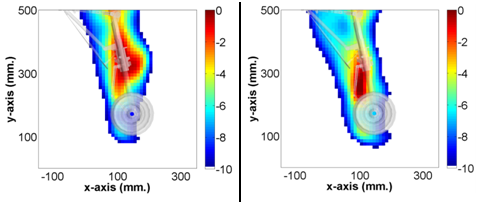
Fully-dressed model Partially-dressed model
Beamforming results for different model configurations

Motivation
-
Separated flow past an airfoil is characterized by multiple natural frequencies associated with various instabilities.
- Traditional separation control forces at a single frequency and often neglects the influence of actuator dynamics (resonance).
Questions & Objectives
- Is the effectiveness of a control strategy related to the natural flow instabilities and/or interactions?
Objective 1: Identify and analyze the various global dynamics in a separated flow configuration
- Can we detect and leverage natural instabilities to understand, model, and control separated flow in a more efficient and systematic manner?
Objective 2: Investigate the effectiveness and efficiency of targeting the instabilities in open-loop experiments
Objective 3: Apply observations to design and implement effective closed-loop control strategies
Challenges & Approach
1. Traditional experimental methods for detection of flow frequency content are limited
- Localized dynamic sensors (location sensitive)
- High-rate global measurements ($$$)
Approach: Use modal analysis methods amenable to experimental techniques to obtain low-order, global estimates
2. Characteristics of 2D flow separation on airfoils is highly dependent on angle of attack and surface curvature
Approach: A canonical flat plate model retains the essential separation characteristics, eliminates curvature effects, and is amenable to both simulations and experiments
Experimental Objectives
1. Estimate global flow dynamics (time-resolved velocity fields)
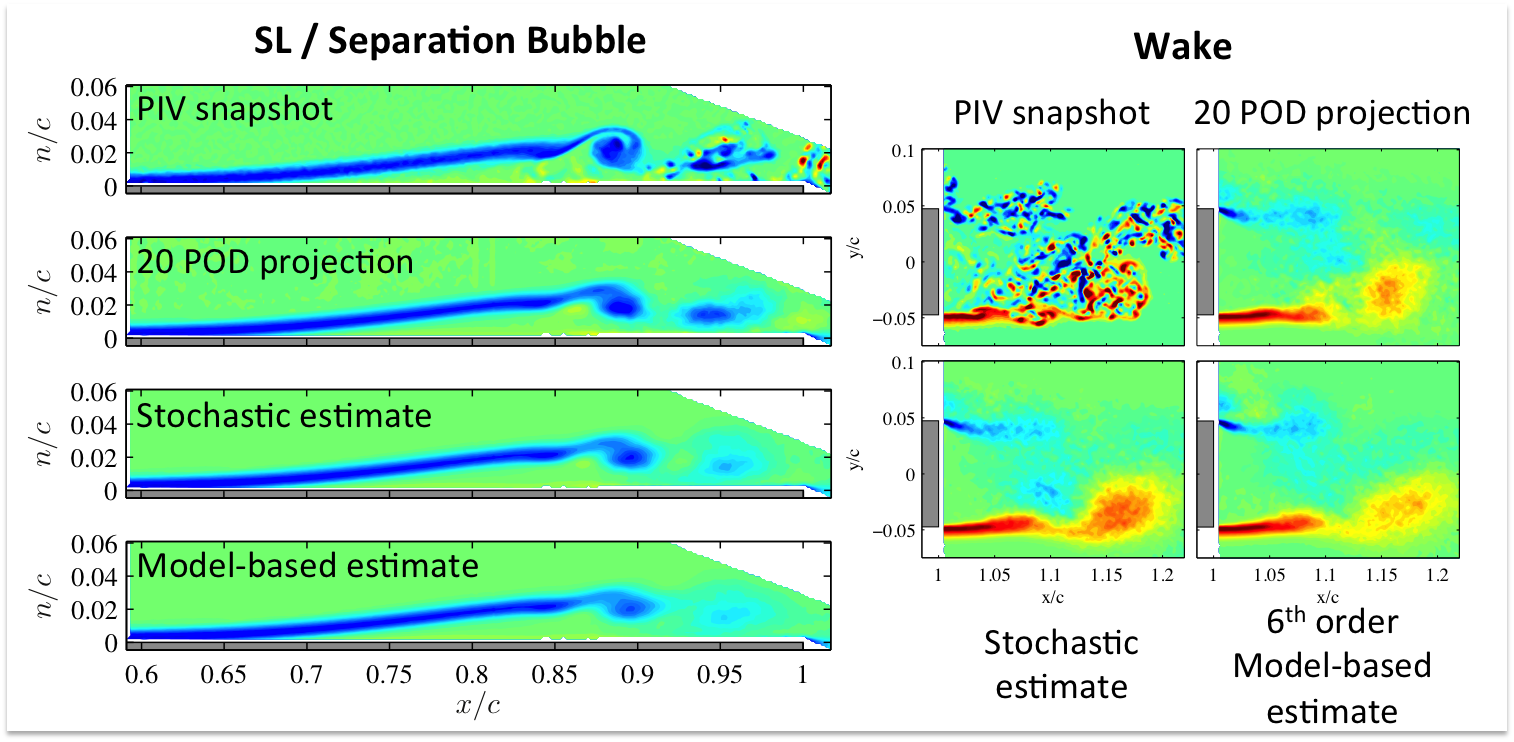
2. Identify characteristic frequencies/instabilities
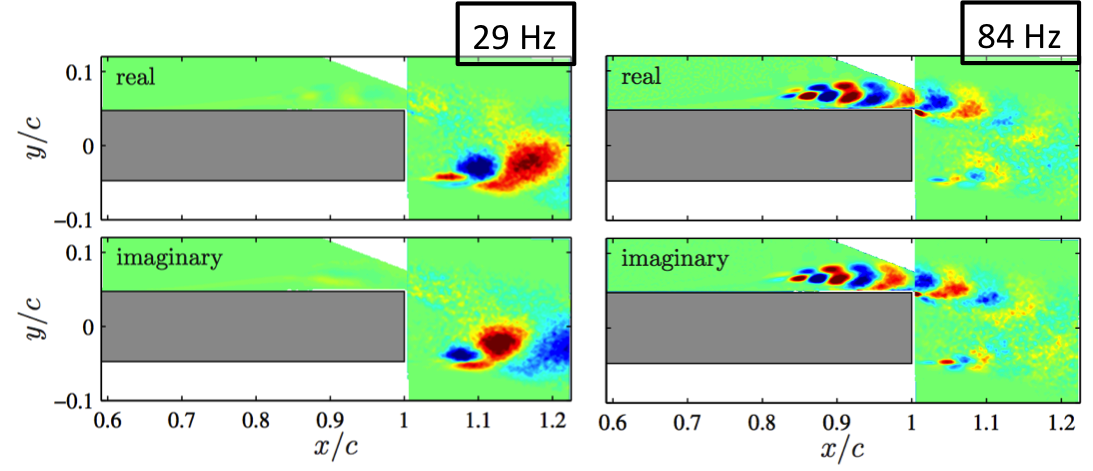
3. Perform open-loop control
Target characteristic frequencies by modulating actuator resonance. The extent and height of the time-averaged separation bubble is reduced during control.

Forcing at or near the natural shear layer frequency "feeds" the characteristic roll-up of the shear layer, which increases mixing between the high-momentum freestream and the low-momentum separated flow. This ultimately reattaches the flow further upstream with little control effort, or cost, described by the coefficient of momentum Cμ.

Conclusions
-
DMD extracts modal structures of the characteristic shear layer and wake components and results reveal interaction between the wake and separation bubble dynamics
-
Most efficient OL control scheme targets multiple flow instabilities rather than a single instability
- CL control reattaches the flow (time average) by reducing the controlled shear layer oscillations
Trailing edge noise is a major aircraft noise source which needs to be addressed if designers wish to continue their trend of making quieter aircraft with each new generation. This noise source, due to the scattering of pressure fluctuations in the wing boundary layer and near wake by the rear edge of the wing, requires extensive experimental analysis for validation of theoretical and computational models. However, experiments performed decades ago are now found to have significant flaws in their results. Modern experimental methods readily show the weaknesses in the older analysis techniques as well as limitations in newer techniques. A library of acoustic data for a NACA 63-215 Mod-B airfoil is obtained and analyzed using coherent power and beamforming techniques. Results show that the methods predict similar levels when airfoil trailing edge noise is the dominant source in the facility. When distributed background noise sources are dominant, nominal predictions do not agree, but method uncertainties become sufficiently large that exact level estimates are identified as unreliable.
Description

Passenger expectations for a quiet flight experience [1] coupled with concern about long-term noise exposure of flight crews [2] drive aircraft manufacturers to reduce cabin noise in flight. Cabin noise has traditionally been limited using insulating panels and skin dampers on the fuselage. Unfortunately, these thin panels are not effective at reducing low frequency (long wavelength) noise and cannot be made thicker due to weight concerns [1]. Treating the noise at its source shows potential for reduction of low frequency noise and weight savings compared to insulating panels. With fuel costs rapidly increasing, reduction of excess weight and subsequent maximization of the "revenue-generating payload" [3] is more important than ever.
In order to identify noise sources and assess the impact of noise reduction technologies during the design process, aircraft manufacturers require robust, low cost microphones. Measuring primary sources of cabin noise, such as shockcell noise, is difficult under simulated cruise conditions in test facilities [1] and establishes the need for microphones that can be used in full-scale tests at altitude. Their use on the fuselage exterior requires extremely small packaged sizes, in addition to the ability to withstand moisture and freezing conditions at flight altitudes. Microelectromechanical systems (MEMS) microphones show promise for meeting the stringent performance requirements of aircraft manufacturers at reduced size and cost, made possible using batch fabrication technology [4-9].
In this work, models are developed to predict performance of a MEMS piezoelectric microphone, including a laminated piezoelectric composite plate model and a lumped element model to capture dynamic behavior. These models are implemented in an optimization procedure for minimization of minimum detectable pressure (MDP) to yield an optimal design that meets the stringent dynamic range constraints for aeroacoustic applications. The optimal design is fabricated and characterized.

Lumped Element Model (LEM) of the MEMS Piezoelectric Mic
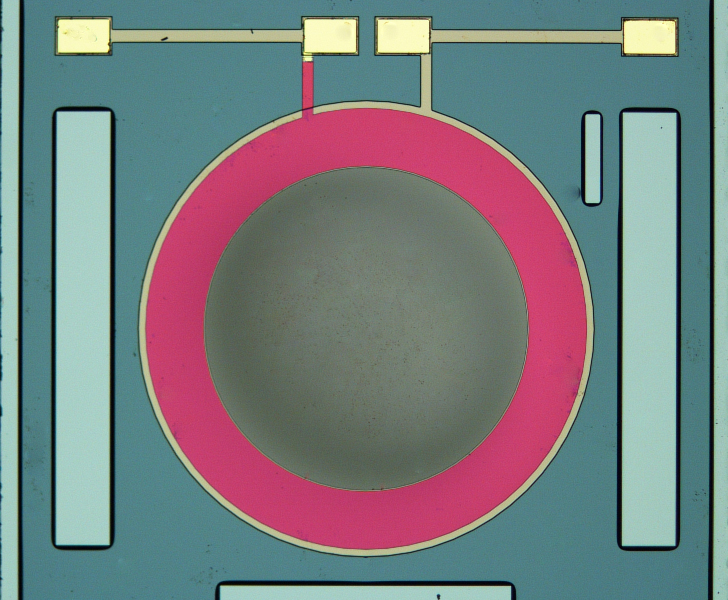
Piezoelectric MEMS Mic Die
References
- V. G. Mengle, U. Ganz, E. J. Bultemeier, and F. T. Calkins, "Clocking effects of chevrons with azimuthally-varying immersions on shockcell/cabin noise," in Proceedings of the 29th AIAA Aeroacoustics Conference, AIAA Paper #08- 3000, Vancouver, British Columbia Canada, 2008, AIAA.
- International Civil Aviation Organization, "Occupational safety and health protections for cabin crew members," in 36th Assembly of the International Civil Avation Organization, A36-WP/208, Montreal, Canada, September 2007.
- V. G. Mengle, U. Ganz, E. Nesbitt, E. J. Bultemeier, and R. Thomas, "Flight test results for uniquely tailored propulsion-airframe aeroacoustic chevrons: Shockcell noise," in Proceedings of the 27th AIAA Aeroacoustics Conference,AIAA Paper #08-3000, Cambridge, MA, 2008, AIAA.
- P. J. King and J. R. Underbrink, "Characterization of a microelectromechanical systems (MEMS) microphone," in 14th AIAA/CEAS Aeroacoustics Conference, Vancouver, British Columbia, Canada, 2008, AIAA.
- M. Sheplak, K. S. Breuer, and M. A. Schmidt, "A wafer-bonded, silicon-nitride membrane microphone with dielectrically-isolated single crystal silicon piezo- resistors," in Proceedings of 1998 Solid-State Sensor and Actuator Workshop, Hilton Head Island, SC, 1998, pp. 23-26.
- M. Sheplak, M. Seiner, K. S. Breuer, and M. A. Schmidt, "A MEMS microphone for aeroacoustic measurements," in Proceedings of 37th AIAA Aerospace Sciences Meeting, AIAA Paper #99-0606, Reno, NV, 1999, AIAA.
- D. P. Arnold, S. Gururaj, S. Bhardwaj, T. Nishida, and M. Sheplak, "A piezoresistive microphone for aeroacoustic measurements," in Proceedings of ASME IMECE 2001, International Mechanical Engineering Congress and Exposition, New York, NY, 2001, pp. 281-288, ASME.
- S. Horowitz, T. Nishida, L. Cattafesta, and M. Sheplak, "Development of a micromachined piezoelectric microphone for aeroacoustics applications," Journal of the Acoustical Society of America, vol. 122, pp. 3428-3436, 2007.
- D. Martin, Design, fabrication, and characterization of a MEMS dual-backplate capacitive microphone, Ph.D. dissertation, University of Florida, Gainesville, FL, 2007.
Increases in air traffic and tighter restrictions on noise pollution in and around airports have motivated research to reduce the aeroacoustic noise generated by aircraft. Aeroacoustic testing with microphone arrays is used to identify and help design acoustic treatments on new and existing aircraft in order to reduce the noise signature of the aircraft. The performance of a microphone array is a function of the number of microphones used, which is traditionally limited by the cost of each sensor. Piezoresistive MEMS microphones take advantage of batch fabrication wafer processing to reduce sensor cost and achieve higher sensor packing densities in aeroacoustic arrays. Thus, an increase in performance can be achieved for an equivalent, or possibly reduced, cost.
Active flow control is the foundation of future innovative aerodynamic concepts for improved vehicle efficiency. However, the active flow control community generally lacks efficient, powerful actuators and, more importantly, corresponding validated design methodologies capable of demonstrating potential benefits at realistic vehicle flight Mach numbers and Reynolds numbers. This research brings together a multidisciplinary team with expertise in electromechanical transducers, lumped element modeling, CFD, and experimental fluid dynamics to model, design, fabricate, and test advanced ZNMF actuators that use different transduction schemes: including piezoelectric and electrodynamic. The outcome of this research is a validated constrained design optimization tool that enables a class of robust ZNMF actuators for deployment on a larger scale.
The objective of the effort is to transition high-performance micromagnets into fully-integrated, batch-fabricated micromagnetic actuators for applications such as micro adaptive flow control.
Motivation
Magnetically-based electromechanical actuation schemes are ubiquitous in macroscale systems such as audio speakers, relays, solenoids, and electrical motors. However, implementation of these transduction schemes at the microscale is nearly nonexistent because of certain design and fabrication challenges—primarily the inability to integrate high-performance, permanent-magnet (magnetically-hard) films within more complex micromachined structures. As a result, most microfabricated transducers rely on other transduction mechanisms (e.g. electrostatic, piezoelectric, thermoelastic). However, these mechanisms limit the actuation force, stroke (displacement), power density, and efficiency necessary for certain applications.
The proposed actuator uses an adaptable and scalable actuation scheme, in that the device structure can be tailored for a wide range of applications. Examples include micro pumps/valves for microfluidic (gas or liquid) systems; high power density motors/actuators for microrobotics; or low-profile acoustic radiators for navigations/sensing. The evolution of fully-integrated micromagnetic transducers will enable performance improvements for existing applications and opportunities to explore new transformative technologies.
Objectives
(1) to validate and characterize the integrability (chemical stability, temperature stability, mechanical reliability, magnetization methods etc.) of the permanent magnet materials in complex microfabrication process flows
(2) to model and optimize a multi-magnet out-of-plane microactuation scheme
(3) to fabricate and characterize a fully-integrated out-of-plane piston-type actuator that can be directly implemented as a micro aerodynamic control surface or adapted as a synthetic jet actuator
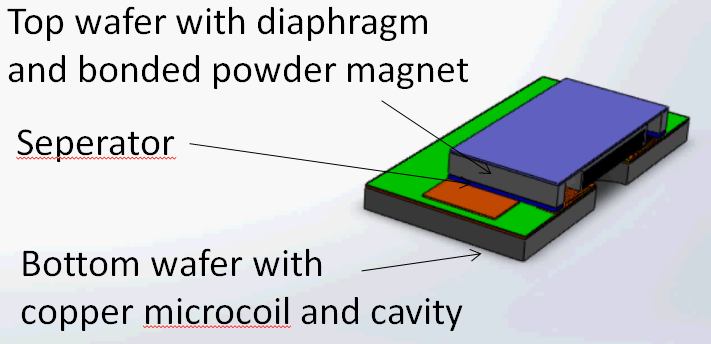
(a)
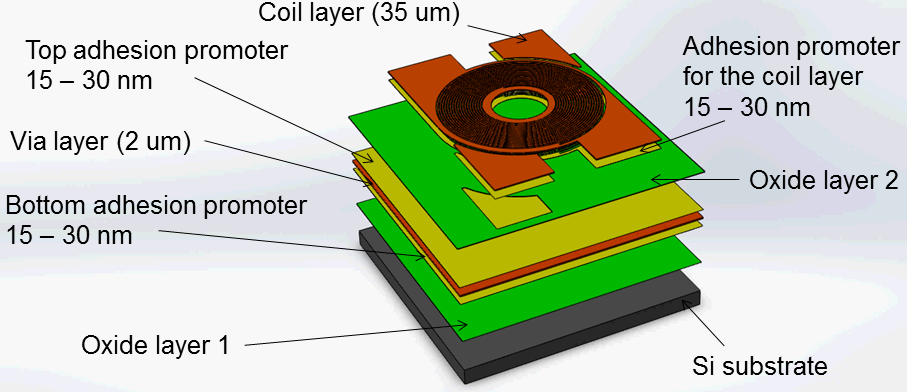
(b)
Figure 1: CAD drawings of the proposed micro-electrodynamic synthetic jet actuator actuator: (a) Actuator assembly comprising two dies made from silicon substrate, separated by a separator. The top die is covered with a PDMS diaphragm and has a bonded powder magnet in the center. (b) Exploded view of the bottom wafer.
Directed energy applications require accurate and efficient transmission of optical energy to an intended target. A three dimensional turret design consisting of a hemispherical top with a flat aperture has proven to provide a convenient method of pointing and tracking lasers from airborne platforms. However, the turret's three-dimensional blunt design leads to complex separation phenomena which, in turn, leads to distortion in an otherwise planar emerging laser beam. This research proposes to develop an adaptive feedback control system to control the flow field around the turret in order to improve aero-optic performance.
The goal of this research is to develop a pressure sensor and shear stress sensor that are able to provide continuous, time-resolved flow measurements within high temperature environments such as those seen in hypersonic wind tunnels and turbines. A primary focus of this research is on the micromachining of sapphire using a picosecond laser. Sapphire’s mechanical and thermal properties make it an ideal material for high temperature measurements. Each sensor operates by mechanically deflecting under either a pressure or shear stress. These deflections can then be detected using an opto-mechanical transduction scheme. The completed sensors will be tested in flow cells and wind tunnels at UF as well as in other transonic and hypersonic facilities.
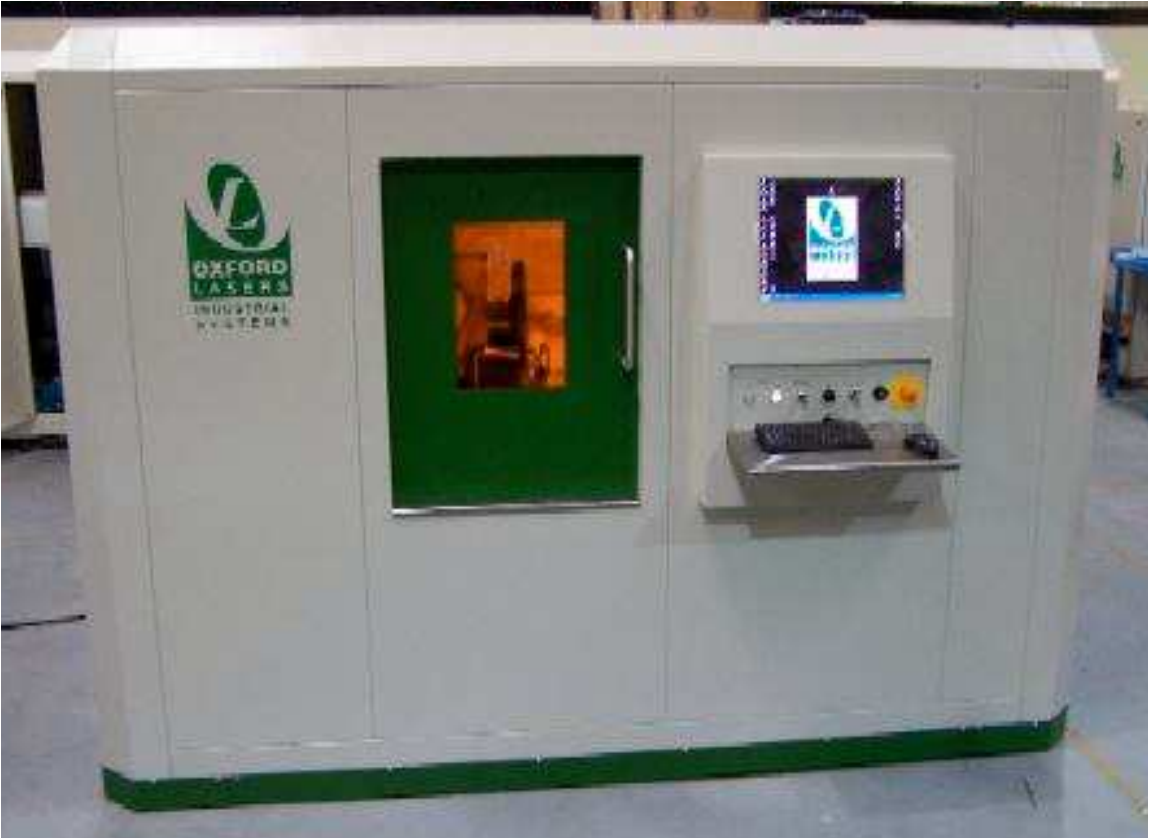
J-355PS Picosecond Laser Micromachining Workstation from Oxford Lasers
Laser micromachined sapphire h-bar sensor structure
The overall goal of this SBIR effort is to develop a rapid, portable system to test for presence and viability of coliform bacteria and E. coli in field water samples. The end system will be portable, battery-powered, reusable, easy to use, and selective to the specific indicator organism.
Clean drinking water is a mission-critical asset for deployed defense personnel. The presence of pathogenic bacteria in water systems can cause widespread illness and even death, and thereby significantly hinder warfighter readiness and effectiveness. Army, Air Force and Navy preventive medicine personnel all share similar potable water monitoring requirements, which includes monitoring indicator organisms that are linked to fecal contamination such as generic Escherichia coli (E. coli.) and coliform bacteria [1] The total concentration of bacterial coliforms (i.e., non spore-forming Gram negative bacteria) is used as an indication of overall sanitary quality, and generic E. coli presence is a hallmark indicator for fecal contamination and potential waterborne pathogens. However, the current approved methods require extensive time and personnel training and thus there is a critical technology gap for rapid, on-site detection of microbial contamination, which is especially important for testing drinking water sources such as surface water, ground water, or host-nation municipal water systems. Further, current field-ready methodologies for detecting fecal organism(s) have challenges related to false positives from non-targets (e.g., microorganisms, native flora, particulate matter), and lack the ability to discriminate between viable and non-viable bacteria.
The innovation of this work is the combination of enabling micro/nanotechnologies under development at the University of Florida for rapid concentration/purification of target bacteria from raw water samples, viability discrimination using fluorescent labels, and subsequent analysis using simple imaging via a portable microscope or smartphone. This system will profoundly improve water-testing protocols by reducing test time, cost, and logistical burden. Such advancements will not only fill a critical technology gap unmet by any other competing technology for defense environments, but also potentially improve sanitation and food safety in other public and private domains (farms, municipal water systems, hospitals/clinics, etc.)
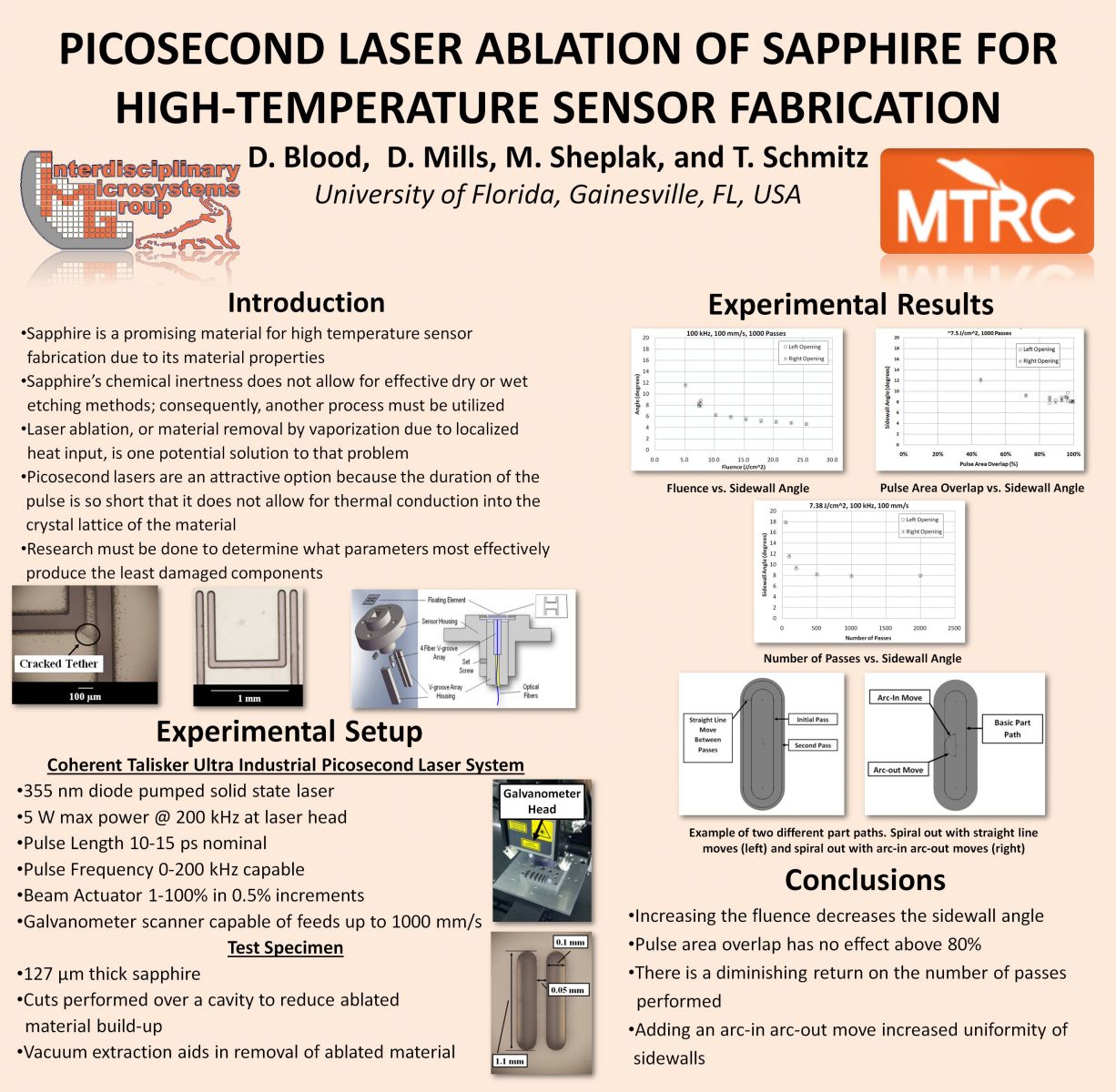
As engineers seek to design more efficient gas turbines, they require a detailed understanding of fundamental thermal-fluid phenomena, as well as active control methods, in high-temperature environments. The high-temperature requirement is based on the increasing turbine inlet temperatures, which have risen to 1500 C, in combined cycle systems in order to improve turbine peak power and efficiency. The limited survivability of silicon-based MEMS sensors in high-temperature and harsh environments has caused researchers to investigate other materials for high-temperature MEMS-based sensors; more specifically sapphire.
Sapphire’s material properties make its entry into the world of high temperature sensors promising, but it also renders most traditional MEMS manufacturing methods impractical. Sapphire’s chemical inertness does not allow for effective dry or wet etching; consequently, a more effective method of machining the material is necessary. One potential solution is to use laser ablation, or material removal by vaporization due to localized heat input, to pattern the material. Femtosecond and picosecond pulsed lasers have shown the ability to reduce or eliminate the thermal damage issues of longer pulsed lasers. These lasers are classified as ultrashort pulse width because the duration of the pulse is so short that it does not allow for thermal conduction into the crystal lattice of the material.
The WEAV is a vehicle which is propelled by a plasma (ionized gas) discharge, requires no moving parts and provides near-instantaneous response. The vehicle operates in atmospheric pressure and is capable of 360° maneuverability. The key to the success of the project is to reduce the ratio of power to vehicle weight while significantly increasing the thrust generation capabilities of the plasma discharge.
Research Objectives
To develop a wireless shear-stress sensor array to provide three-dimensional, time-resolved, fluctuating skin friction data to aid turbulence model development.
Approach
Each sensor is effectively an LC tank made up of a variable-capacitance floating element and an integrated inductor. The sensing antenna is inductively coupled to the tank and can detect a change in the resonant frequency caused by a displacement of the floating element. An array is realized by designing each sensor to have it’s own unique resonant frequency. Then a single broad spectrum antenna can monitor the entire array.
Broader Impact
The realization of such an array will enable fundamental scientific studies of complex turbulent flows. It could also be implemented into a feedback control system for future air vehicles employing active flow control.
Materials, Manufacturing, and Modeling
In their effort to locate, understand and mitigate the impact of noise sources on an aircraft, aeroacousticiansare in need of a high performance, low cost microphone to combat the increasing noise restrictions on commercial aircraft. Existing commercial sensors, even with their relatively high cost, in some cases constrain the quality and type of measurement that may be achieved. One such constraint is that the physical size and characteristics of the sensors limit the optimal locations in which the sensors may be placed. Previous generations of MEMS aeroacoustic microphones have failed to address the need for a sensor that can be packaged and installed with a smooth front surface to be used for boundary layer measurements in a fuselage array at cruise conditions. Additionally, these microphones must meet demanding requirements, including the sensing of high sound pressure levels (>160 dB) with low distortion (<3%) and high sensitivity stability (with respect to moisture and freezing) over temperatures from -60°F to 150°F. This work addresses the limitations of existing MEMS piezoelectric microphones used in aeroacoustic applications by incorporating through-silicon vias(TSVs) into the fabrication to eliminate the use of wirebondsthat affect the flow field and create an overall flush-mount microphone package.
Description

Passenger expectations for a quiet flight experience [1] coupled with concern about long-term noise exposure of flight crews [2] drive aircraft manufacturers to reduce cabin noise in flight. Cabin noise has traditionally been limited using insulating panels and skin dampers on the fuselage. Unfortunately, these thin panels are not effective at reducing low frequency (long wavelength) noise and cannot be made thicker due to weight concerns [1]. Treating the noise at its source shows potential for reduction of low frequency noise and weight savings compared to insulating panels. With fuel costs rapidly increasing, reduction of excess weight and subsequent maximization of the "revenue-generating payload" [3] is more important than ever.
In order to identify noise sources and assess the impact of noise reduction technologies during the design process, aircraft manufacturers require robust, low cost microphones. Measuring primary sources of cabin noise, such as shockcell noise, is difficult under simulated cruise conditions in test facilities [1] and establishes the need for microphones that can be used in full-scale tests at altitude. Their use on the fuselage exterior requires extremely small packaged sizes, in addition to the ability to withstand moisture and freezing conditions at flight altitudes. Microelectromechanical systems (MEMS) microphones show promise for meeting the stringent performance requirements of aircraft manufacturers at reduced size and cost, made possible using batch fabrication technology [4-9].
In this work, models are developed to predict performance of a MEMS piezoelectric microphone, including a laminated piezoelectric composite plate model and a lumped element model to capture dynamic behavior. These models are implemented in an optimization procedure for minimization of minimum detectable pressure (MDP) to yield an optimal design that meets the stringent dynamic range constraints for aeroacoustic applications. The optimal design is fabricated and characterized.

Lumped Element Model (LEM) of the MEMS Piezoelectric Mic

Piezoelectric MEMS Mic Die
References
- V. G. Mengle, U. Ganz, E. J. Bultemeier, and F. T. Calkins, "Clocking effects of chevrons with azimuthally-varying immersions on shockcell/cabin noise," in Proceedings of the 29th AIAA Aeroacoustics Conference, AIAA Paper #08- 3000, Vancouver, British Columbia Canada, 2008, AIAA.
- International Civil Aviation Organization, "Occupational safety and health protections for cabin crew members," in 36th Assembly of the International Civil Avation Organization, A36-WP/208, Montreal, Canada, September 2007.
- V. G. Mengle, U. Ganz, E. Nesbitt, E. J. Bultemeier, and R. Thomas, "Flight test results for uniquely tailored propulsion-airframe aeroacoustic chevrons: Shockcell noise," in Proceedings of the 27th AIAA Aeroacoustics Conference,AIAA Paper #08-3000, Cambridge, MA, 2008, AIAA.
- P. J. King and J. R. Underbrink, "Characterization of a microelectromechanical systems (MEMS) microphone," in 14th AIAA/CEAS Aeroacoustics Conference, Vancouver, British Columbia, Canada, 2008, AIAA.
- M. Sheplak, K. S. Breuer, and M. A. Schmidt, "A wafer-bonded, silicon-nitride membrane microphone with dielectrically-isolated single crystal silicon piezo- resistors," in Proceedings of 1998 Solid-State Sensor and Actuator Workshop, Hilton Head Island, SC, 1998, pp. 23-26.
- M. Sheplak, M. Seiner, K. S. Breuer, and M. A. Schmidt, "A MEMS microphone for aeroacoustic measurements," in Proceedings of 37th AIAA Aerospace Sciences Meeting, AIAA Paper #99-0606, Reno, NV, 1999, AIAA.
- D. P. Arnold, S. Gururaj, S. Bhardwaj, T. Nishida, and M. Sheplak, "A piezoresistive microphone for aeroacoustic measurements," in Proceedings of ASME IMECE 2001, International Mechanical Engineering Congress and Exposition, New York, NY, 2001, pp. 281-288, ASME.
- S. Horowitz, T. Nishida, L. Cattafesta, and M. Sheplak, "Development of a micromachined piezoelectric microphone for aeroacoustics applications," Journal of the Acoustical Society of America, vol. 122, pp. 3428-3436, 2007.
- D. Martin, Design, fabrication, and characterization of a MEMS dual-backplate capacitive microphone, Ph.D. dissertation, University of Florida, Gainesville, FL, 2007.
Increases in air traffic and tighter restrictions on noise pollution in and around airports have motivated research to reduce the aeroacoustic noise generated by aircraft. Aeroacoustic testing with microphone arrays is used to identify and help design acoustic treatments on new and existing aircraft in order to reduce the noise signature of the aircraft. The performance of a microphone array is a function of the number of microphones used, which is traditionally limited by the cost of each sensor. Piezoresistive MEMS microphones take advantage of batch fabrication wafer processing to reduce sensor cost and achieve higher sensor packing densities in aeroacoustic arrays. Thus, an increase in performance can be achieved for an equivalent, or possibly reduced, cost.
The objective of the effort is to transition high-performance micromagnets into fully-integrated, batch-fabricated micromagnetic actuators for applications such as micro adaptive flow control.
Motivation
Magnetically-based electromechanical actuation schemes are ubiquitous in macroscale systems such as audio speakers, relays, solenoids, and electrical motors. However, implementation of these transduction schemes at the microscale is nearly nonexistent because of certain design and fabrication challenges—primarily the inability to integrate high-performance, permanent-magnet (magnetically-hard) films within more complex micromachined structures. As a result, most microfabricated transducers rely on other transduction mechanisms (e.g. electrostatic, piezoelectric, thermoelastic). However, these mechanisms limit the actuation force, stroke (displacement), power density, and efficiency necessary for certain applications.
The proposed actuator uses an adaptable and scalable actuation scheme, in that the device structure can be tailored for a wide range of applications. Examples include micro pumps/valves for microfluidic (gas or liquid) systems; high power density motors/actuators for microrobotics; or low-profile acoustic radiators for navigations/sensing. The evolution of fully-integrated micromagnetic transducers will enable performance improvements for existing applications and opportunities to explore new transformative technologies.
Objectives
(1) to validate and characterize the integrability (chemical stability, temperature stability, mechanical reliability, magnetization methods etc.) of the permanent magnet materials in complex microfabrication process flows
(2) to model and optimize a multi-magnet out-of-plane microactuation scheme
(3) to fabricate and characterize a fully-integrated out-of-plane piston-type actuator that can be directly implemented as a micro aerodynamic control surface or adapted as a synthetic jet actuator

(a)

(b)
Figure 1: CAD drawings of the proposed micro-electrodynamic synthetic jet actuator actuator: (a) Actuator assembly comprising two dies made from silicon substrate, separated by a separator. The top die is covered with a PDMS diaphragm and has a bonded powder magnet in the center. (b) Exploded view of the bottom wafer.
The details of the research efforts are proprietary.
The details of the research efforts are proprietary.
The details of the research efforts are proprietary.
The details of the research efforts are proprietary.
This industry-sponsored project is funded by the MIST Center. The specific details of this project are confidential.
The Multi-functional Integrated System Technology (MIST) Center is an NSF Industry/University Cooperative Research Center (I/UCRC) led by the University of Florida and the University of Central Florida. Our mission is to facilitate integration of novel materials, processes, devices, and circuits into multi-functional systems through research partnerships between university, industry, and government stakeholders. With ~30 faculty participants from 6 different departments, the MIST Center serves as an early-stage research sandbox for developing next-generation smart systems in the Internet of Things era.
AlGaN/GaN HEMTs are regarded as promising candidate for RF and high power electronics applications due to unique material properties of GaN, such as, wide band gap, high breakdown field, high carrier mobility, and large saturation velocity. Other advantageous characteristics, such as, piezoelectricity and spontaneous polarization within AlGaN and GaN layers result in high 2D electron gas densities. However the wide deployment of the AlGaN/GaN HEMT technology is currently hindered due to its limited electrical reliability. Achieving high-level of reliability concurrently with high power operation remains an important challenge for this technology. Improvements in the reliability of these devices require a thorough understanding of the failure mechanisms that degrade the device performance.
Studies show that AlGaN/GaN HEMTs degrade significantly under typical device operation. Degradation in these devices has been hypothesized to occur due to charge trapping, hot electron effects, and crystallographic defect formation due to inverse-piezoelectric effect. GaN HEMTs have high internal stresses resulting from lattice mismatch between GaN and AlGaN layers and generated during device operation due to inverse piezoelectric effect. Mechanical stress impacts the device performance by affecting the carrier mobility, polarization, band-gap, trap energy levels and trap generation and hence influences the reliability of these devices. The goal of this project is to investigate the effect of stress, bias and temperature on device characteristics and understand the fundamental physics governing the device operation; and hence the failure mechanisms that degrade the device performance. Four-point mechanical wafer bending is used to study the effect of stress on AlGaN/GaN HEMT channel resistance and gate current to provide insight on the role of stress in device reliability.
Technological advances in microelectrode neural probes have great potential to benefit patients with neurological diseases and injuries because they allow for direct interfacing and intervention with neurons of the nervous system. The interface design involves chronically collecting neural activity directly from the cortex of the brain, interpreting its information, and delivering therapy via an electronic interface. Such Brain-Machine Interface (BMI) systems that are capable of recording and processing the activity of large ensembles of cortical neurons have the potential to allow paralyzed individuals to communicate with the external world via computer control or direct control of prosthetic limbs and wheelchairs.We design, fabricate, and test flexible microelectrode array that can be hybrid-packaged with custom electronics in a fully implantable form factor to realize a self sustained BMI system. Also the flexible cable will provide strain relief to the implanted electrode and potentially improve long term viability.
This project aims at designing novel micromachining techniques for polymer-based flexible substrate microelectrodes as well as defining requirements for recording amplification, signal processing, and wireless telemetry systems. Much effort is going into the design and fabrication of highly compliant 2D electrodes which will potentially increase the possibilities of achieving reliable neural recordings over a chronic period . All efforts are in attempt to further the field of chronic neural recording for neuroprosthetic therapies.
This industry-sponsored project is funded by the MIST Center. The specific details of this project are confidential.
The Multi-functional Integrated System Technology (MIST) Center is an NSF Industry/University Cooperative Research Center (I/UCRC) led by the University of Florida and the University of Central Florida. Our mission is to facilitate integration of novel materials, processes, devices, and circuits into multi-functional systems through research partnerships between university, industry, and government stakeholders. With ~30 faculty participants from 6 different departments, the MIST Center serves as an early-stage research sandbox for developing next-generation smart systems in the Internet of Things era.
The overall goal of UF’s effort on this DARPA Atoms to Products program (under sub-contract to SRI International) is to manufacture the micro-robots for demonstration of a massively parallel (1,000+) micro-robot factory. Each micro-robot comprises at least one magnetic base and one end effector. The magnetic base is configured with a pattern of north and south poles. A starting design is a 3 mm x 3 mm x 0.4 mm thick base that is arranged into a 9-pole checkerboard pattern. The simplest end effector is a simple mechanical rod attached to the top of the magnetic case.
The micro-robot platforms (magnetic bases and end effectors) will be mass manufactured using a combination of precision manufacturing and microfabrication techniques. Rather than assembling discrete magnets into specific pole patterns, selective magnetization techniques will be used to “imprint” the desired pole pattern into mechanically contiguous layers. These methods will eliminate the need for assembly, and also facilitate the massive batch manufacture of many magnetic bases in parallel. Concurrently, end effectors will be microfabricated using suitable microfabrication technologies. The bases and end effectors will be combined together via monolithic co-fabrication or via wafer-scale batch-assembly processes.
The goal of this research is to develop a pressure sensor and shear stress sensor that are able to provide continuous, time-resolved flow measurements within high temperature environments such as those seen in hypersonic wind tunnels and turbines. A primary focus of this research is on the micromachining of sapphire using a picosecond laser. Sapphire’s mechanical and thermal properties make it an ideal material for high temperature measurements. Each sensor operates by mechanically deflecting under either a pressure or shear stress. These deflections can then be detected using an opto-mechanical transduction scheme. The completed sensors will be tested in flow cells and wind tunnels at UF as well as in other transonic and hypersonic facilities.

J-355PS Picosecond Laser Micromachining Workstation from Oxford Lasers
Laser micromachined sapphire h-bar sensor structure
Objectives
To develop electro-mechanical inductors coupling between a conventional inductor and a mechanical resonator that passively store energy via both electromagnetic and mechanical mechanisms.
Benefits
Enable high density inductive energy storage, and potentially lighter, more efficient power converters.
Concept
Model
Preliminary Results
Research Objective
To investigate the use of advanced microfabrication technologies and MEMS-enabled magnetization methods in developing reduced-scale permanent magnet undulator structures (with fine pole pitch ~5 microns) while maintaining reasonable magnetic field strengths as well as efficient generation of brilliant, high energy (>10keV) mono-energetic x-rays from modest electron beam source energies (~200MeV).
Theory
An accelerated beam of electrons with relativistic velocities experiences an undulation when passing through a spatially periodic magnetic field. This undulation of the beam trajectory results in the generation of electromagnetic radiation from which intense, tunable x-rays can be produced.
Magnetic Particle Imaging (MPI) is a new tomographic imaging technique that maps the spatial distribution of iron oxide magnetic nanoparticles (MNPs) in real time and with spatial resolution that is on par or better than other biomedical imaging techniques. In this project, we will develop a theoretical foundation relating the properties of MNPs and MPI magnetic field conditions to the MPI signal strength and resolution. These efforts will yield design rules that will guide the rational design of future generations of MNP tracers for MPI. The proposed research will enable development of a novel biomedical imaging technique capable of high resolution real time imaging using nontoxic tracers suitable for a variety of biomedical applications.
The objective of this research is to develop new manufacturing processes for the magnetic components used in modern electronic systems. The goal is improve the manufacturability, performance, and energy efficiency of power supplies and communication devices, while simultaneously reducing their size and weight. A novel process is used to combine the properties of two different magnetic materials by embedding magnetic particles of one type of material inside of a second material. The result is a new, hybrid magnetic material that exhibits improved material properties compared to existing materials. In the long run, these new magnetic materials are aimed to enable next-generation mobile electronics, communication systems, robotics, and medical devices. The project will strengthen an industry/university research partnership between the University of Florida and Electron Energy Corporation via technical exchange and a graduate student summer internship. The project also aims to broaden participation and retention of female and minority students in STEM career fields.
Magnetic components used in modern electronic systems require compromising tradeoffs in size, power, and efficiency due to the lack of magnetic materials that simultaneously exhibit high saturation and low loss at MHz to GHz frequencies. To overcome this bottleneck a novel electro-infiltration process is proposed, wherein magnetic nanoparticles are consolidated onto a surface, and the inter-particle gaps are filled by an electroplated magnetic material. The result is a two-phase nanocomposite with potentially transformative magnetic properties, along with a disruptive manufacturing technology integrate these materials within a variety of electronic systems. From a scientific standpoint, the electro-infiltration process provides a unique platform to fabricate new nanocomposite architectures. This enables fundamental exploration of exchange-coupled or nanogranular soft magnetic cores, as well as hard (permanent) magnetic materials. The long-term impact of this work would be a scalable, end-to-end manufacturing process for compact magnetic device components with exceptional performance, low manufacturing cost, and integration with other electronic devices. The specific aims of this one-year EAGER proposal are to validate the feasibility of the process, while beginning to optimize micro/nanofabrication methods and elucidate structure/property/performance relationships for these new electro-infiltrated nanocomposite magnetic materials.
Detection of fecal indicating bacteria plays an important role in water quality monitoring to ensure safe human water contact and/or drinking. Specifically, epidemiological studies by the U.S. Environmental Protection Agency (EPA) have shown strong correlations between illnesses and bacteria concentrations of Enterococci and E. coli in fresh and marine waters. While there has been much work in bacteria detection in water samples, current limitations include long response times (typically 24 hours for incubation of bacteria) and a need for complex lab tools and/or equipment.
We have recently developed a method for rapid (<1 hour) isolation and detection of E. coli with no enrichment steps. We have demonstrated a limit of detection down to 100 CFU/100 mL, which is below the EPA threshold of 125 CFU/100 mL. In this effort, we propose to continue development of this bacterial isolation technology for on-site detection of contaminating bacteria in Puerto Rico’s coastal recreational waters. Specifically, we aim to improve the limit of detection for E. coli, and to demonstrate a rapid (< 1 hour) detection of Enterococci from up to 100 mL samples at concentrations as low as 35 CFU/100 mL with a simple, field-deployable apparatus.
The project proposed herein will make use of bio-functionalized (with aptamers, lectins, antibodies, or others) magnetic microdiscs to isolate fecal contaminating bacteria to be examined via fluorescent imaging using lab epi-fluorescent/confocal microscopes. Also, the use and development of a portable fluorescent imaging apparatus for presence and viability detection of bacteria. Here, a portable platform will be used with a smart-phone device and granulometry image processing algorithms for on-site quantification of bacterial targets. Finally, actuation/stirring of the magnetic microdiscs will be explored to enhance bacteria interaction/binding, hence reducing detection time and limits of detection.
The overall goal of this SBIR effort is to develop a rapid, portable system to test for presence and viability of coliform bacteria and E. coli in field water samples. The end system will be portable, battery-powered, reusable, easy to use, and selective to the specific indicator organism.
Clean drinking water is a mission-critical asset for deployed defense personnel. The presence of pathogenic bacteria in water systems can cause widespread illness and even death, and thereby significantly hinder warfighter readiness and effectiveness. Army, Air Force and Navy preventive medicine personnel all share similar potable water monitoring requirements, which includes monitoring indicator organisms that are linked to fecal contamination such as generic Escherichia coli (E. coli.) and coliform bacteria [1] The total concentration of bacterial coliforms (i.e., non spore-forming Gram negative bacteria) is used as an indication of overall sanitary quality, and generic E. coli presence is a hallmark indicator for fecal contamination and potential waterborne pathogens. However, the current approved methods require extensive time and personnel training and thus there is a critical technology gap for rapid, on-site detection of microbial contamination, which is especially important for testing drinking water sources such as surface water, ground water, or host-nation municipal water systems. Further, current field-ready methodologies for detecting fecal organism(s) have challenges related to false positives from non-targets (e.g., microorganisms, native flora, particulate matter), and lack the ability to discriminate between viable and non-viable bacteria.
The innovation of this work is the combination of enabling micro/nanotechnologies under development at the University of Florida for rapid concentration/purification of target bacteria from raw water samples, viability discrimination using fluorescent labels, and subsequent analysis using simple imaging via a portable microscope or smartphone. This system will profoundly improve water-testing protocols by reducing test time, cost, and logistical burden. Such advancements will not only fill a critical technology gap unmet by any other competing technology for defense environments, but also potentially improve sanitation and food safety in other public and private domains (farms, municipal water systems, hospitals/clinics, etc.)
Despite the fact that nonlinearities are inherent in many natural and engineered systems, it is common for engineers to remove, or attempt to remove, all nonlinearity from their designs. Although this simplifies the performance analyses, it also overlooks a wide array of phenomena that could potentially enable fundamental breakthroughs.
The objective of this project is to derive fundamental insights for complex arrays of nonlinearly coupled oscillators, using structures defined as magneto-mechanical lattices. The magneto-mechanical lattices comprise periodic arrays of dynamically interacting magnets, which can be conceptualized as an array of equivalent springs and masses, or alternatively, as a solid composed of artificial macro-atoms. The nonlinear magnetic coupling is to be theoretically tailored to exploit nonlinear energy transfer behaviors, such as reconfiguring bandgaps, energy localization, internal resonances, etc. These nonlinear phenomena are to be experimentally demonstrated and measured by fabricated magneto-mechanical lattices.
High energy density capacitors are critically important in advanced electronic devices and electric power systems that require bursts of large energy such as pace makers, defibulators, rail guns, electric vehicles and electromagnetic armor. Our work is studying the use of nanocomposites to create ultra high energy density capacitors with particular focus on the role the morphology and orientation of the filler plays on the energy density. Our current results have produced nanocomposites with energy density exceeding 10 J/cc, which is more than twice as large as high performance commercial materials. Efforts to create further gains are focused on the synthesis of new high dielectric ceramic nanowires, approaches for the functionalization of the fillers to achieve improve compatibility with the polymer matrix materials and fabrication approaches to create the highest energy density capacitors available.
High density passive components (inductors, transformers, capacitors) are developed and integrated with high frequency (100-500 MHz) CMOS switching power conversion circuits. The mm3-scale integrated converter will be capable of delivering >20 V from a battery source to enable mobile microsystems such as micro air vehicles and microrobots.
High-inductance-density air core inductors and transformers have been fabricated using a three-dimensional copper electroforming process. These devices have measured inductance densities > 100 nH/mm2 and quality factors > 20. Optimal performance is achieved in the range of 50 MHz - 500 MHz to enable next generation switching converters operating at very high frequencies.


As engineers seek to design more efficient gas turbines, they require a detailed understanding of fundamental thermal-fluid phenomena, as well as active control methods, in high-temperature environments. The high-temperature requirement is based on the increasing turbine inlet temperatures, which have risen to 1500 C, in combined cycle systems in order to improve turbine peak power and efficiency. The limited survivability of silicon-based MEMS sensors in high-temperature and harsh environments has caused researchers to investigate other materials for high-temperature MEMS-based sensors; more specifically sapphire.
Sapphire’s material properties make its entry into the world of high temperature sensors promising, but it also renders most traditional MEMS manufacturing methods impractical. Sapphire’s chemical inertness does not allow for effective dry or wet etching; consequently, a more effective method of machining the material is necessary. One potential solution is to use laser ablation, or material removal by vaporization due to localized heat input, to pattern the material. Femtosecond and picosecond pulsed lasers have shown the ability to reduce or eliminate the thermal damage issues of longer pulsed lasers. These lasers are classified as ultrashort pulse width because the duration of the pulse is so short that it does not allow for thermal conduction into the crystal lattice of the material.
The WEAV is a vehicle which is propelled by a plasma (ionized gas) discharge, requires no moving parts and provides near-instantaneous response. The vehicle operates in atmospheric pressure and is capable of 360° maneuverability. The key to the success of the project is to reduce the ratio of power to vehicle weight while significantly increasing the thrust generation capabilities of the plasma discharge.
Research Objectives
To develop a wireless shear-stress sensor array to provide three-dimensional, time-resolved, fluctuating skin friction data to aid turbulence model development.
Approach
Each sensor is effectively an LC tank made up of a variable-capacitance floating element and an integrated inductor. The sensing antenna is inductively coupled to the tank and can detect a change in the resonant frequency caused by a displacement of the floating element. An array is realized by designing each sensor to have it’s own unique resonant frequency. Then a single broad spectrum antenna can monitor the entire array.
Broader Impact
The realization of such an array will enable fundamental scientific studies of complex turbulent flows. It could also be implemented into a feedback control system for future air vehicles employing active flow control.
We seek to develop a platform that allows magnetic field sensing using a small footprint, in the absence of an external power supply. Our approach uses magnetoelectric nanofibers to create a zero-power magnetic field sensor. The challenge is to develop methods to assemble these materials into devices that leverage their unique anisotropic properties.
The figure of merit for magnetoelectric materials is the magnetoelectric coefficient, a measure of the amount of voltage generated with respect to the magnitude of the applied magnetic field. Bulk magnetoelectrics and thin films are limited by defects and substrate clamping respectively. To overcome the limitations of thin-film based composite magnetoelectrics we have developed magnetoelectric bilayer structures on a single nanofiber, i.e., 1D magnetoelectrics. These materials are theoretically predicted to have magnetoelectric coupling coefficients that are orders of magnitude greater than their thin film counterparts.
Magnetoelectric materials can be employed in a wide variety of applications including magnetic field sensors and tunable resonance energy harvesters. By optimizing for material system and architecture, drastic increases in magnitude of voltage generated with decreased size can be achieved. This could allow for more sensitive magnetic field sensors appropriate for a wider array of applications and decreased size to allow for easier integration into ICs.
Chemical and Biomedical Systems
Technological advances in microelectrode neural probes have great potential to benefit patients with neurological diseases and injuries because they allow for direct interfacing and intervention with neurons of the nervous system. The interface design involves chronically collecting neural activity directly from the cortex of the brain, interpreting its information, and delivering therapy via an electronic interface. Such Brain-Machine Interface (BMI) systems that are capable of recording and processing the activity of large ensembles of cortical neurons have the potential to allow paralyzed individuals to communicate with the external world via computer control or direct control of prosthetic limbs and wheelchairs.We design, fabricate, and test flexible microelectrode array that can be hybrid-packaged with custom electronics in a fully implantable form factor to realize a self sustained BMI system. Also the flexible cable will provide strain relief to the implanted electrode and potentially improve long term viability.
This project aims at designing novel micromachining techniques for polymer-based flexible substrate microelectrodes as well as defining requirements for recording amplification, signal processing, and wireless telemetry systems. Much effort is going into the design and fabrication of highly compliant 2D electrodes which will potentially increase the possibilities of achieving reliable neural recordings over a chronic period . All efforts are in attempt to further the field of chronic neural recording for neuroprosthetic therapies.
Motivation
Diagnosis of early-stage osteoarthritis (OA), a disease stage where emerging therapeutics have demonstrated potential to reduce and prevent OA progression in animal models, remains a significant clinical challenge. However, OA early-stage detection could lead to interventions and change in lifestyle that would reverse the chronic cascade of joint destruction found in the OA-affected joint. Clinically, OA is diagnosed through radiographs and physical exams, yet these diagnostics are relatively poor at detecting early-stage OA. A significant need exists for technologies that facilitate early-stage OA diagnosis. Therefore, direct assessment of molecular changes within an OA-affected joint would overcome these limitations. The goal of this project is to develop a novel magnetic nanoparticle-based technique to collect OA biomarkers from synovial fluid without the need to remove fluid from the joint space.
Our preliminary studies demonstrate a proof-of-concept for magnetic harvesting; however, additional refinement is needed to accurately and repeatedly relate the amount of biomarker collected to the initial biomarker concentration in the synovial fluid.
Research Objectives
The objective is to develop an enhanced, quantitative technique (magnetic harvesting) for the collection of OA biomarkers from synovial fluid in vitro. The magnetic harvesting can be described as: superparamagnetic particles with OA biomarker antibodies conjugated on the particle’s surface (antibody-functionalized particles) are injected into synovial fluid to bind biomarkers within the joint space. A magnetic needle is then used to collect magnetic particle-biomarker conjugates, and biomarkers are finally released for analysis. The influence of the different parameters related will be studied, experimentally and by numerical models, such as antibody dissociation constants, magnetic field distribution around the microneedles, and magnetic properties of the particles. Using these parameters, models that relate the quantity of biomarker collected via magnetic harvesting to the initial biomarker concentration in the synovial fluid will be constructed.
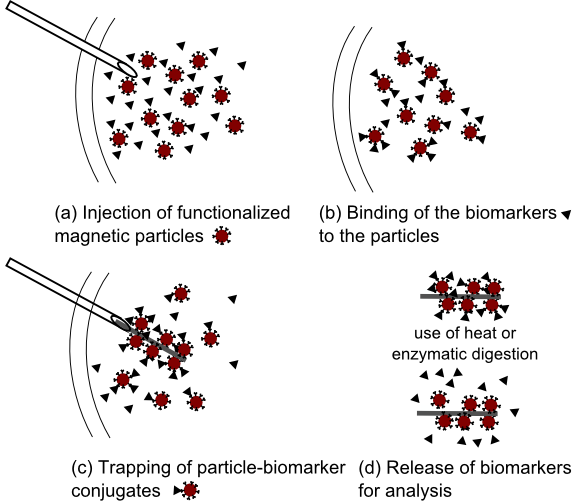
The goal of this project is to develop thermally actuated and manufactuable microfluidic valves for a variety of applications. The valves can be integrated in a device; the actuation of valves will be controlled by a printed circuit board (PCB). The valves are expected to be useful in any system that needs flow controls and fluid metering. The project has been funded by Defense Advanced Research Projects Agency (DARPA), and a project for an immunoassay array involving a number of microvalves is currently funded by National Institute of Health (NIH). More info can be found in this link: http://www2.mae.ufl.edu/%7Ehfan/Research.html
Magnetic Particle Imaging (MPI) is a new tomographic imaging technique that maps the spatial distribution of iron oxide magnetic nanoparticles (MNPs) in real time and with spatial resolution that is on par or better than other biomedical imaging techniques. In this project, we will develop a theoretical foundation relating the properties of MNPs and MPI magnetic field conditions to the MPI signal strength and resolution. These efforts will yield design rules that will guide the rational design of future generations of MNP tracers for MPI. The proposed research will enable development of a novel biomedical imaging technique capable of high resolution real time imaging using nontoxic tracers suitable for a variety of biomedical applications.
The major goal of this project is to develop a MEMS-based miniature imaging probe that can perform three-dimensional imaging in vivo inside human body using nonlinear optical effects.
The goal of this project is to develop a light-weigth optical probe that can be mounted on a freely moving mouse and continuously obtain in vivo 3D imaging of neural activity, particularly using Ca2+ fluorescence imaging. MEMS technology is used for miniaturization.
Detection of fecal indicating bacteria plays an important role in water quality monitoring to ensure safe human water contact and/or drinking. Specifically, epidemiological studies by the U.S. Environmental Protection Agency (EPA) have shown strong correlations between illnesses and bacteria concentrations of Enterococci and E. coli in fresh and marine waters. While there has been much work in bacteria detection in water samples, current limitations include long response times (typically 24 hours for incubation of bacteria) and a need for complex lab tools and/or equipment.
We have recently developed a method for rapid (<1 hour) isolation and detection of E. coli with no enrichment steps. We have demonstrated a limit of detection down to 100 CFU/100 mL, which is below the EPA threshold of 125 CFU/100 mL. In this effort, we propose to continue development of this bacterial isolation technology for on-site detection of contaminating bacteria in Puerto Rico’s coastal recreational waters. Specifically, we aim to improve the limit of detection for E. coli, and to demonstrate a rapid (< 1 hour) detection of Enterococci from up to 100 mL samples at concentrations as low as 35 CFU/100 mL with a simple, field-deployable apparatus.
The project proposed herein will make use of bio-functionalized (with aptamers, lectins, antibodies, or others) magnetic microdiscs to isolate fecal contaminating bacteria to be examined via fluorescent imaging using lab epi-fluorescent/confocal microscopes. Also, the use and development of a portable fluorescent imaging apparatus for presence and viability detection of bacteria. Here, a portable platform will be used with a smart-phone device and granulometry image processing algorithms for on-site quantification of bacterial targets. Finally, actuation/stirring of the magnetic microdiscs will be explored to enhance bacteria interaction/binding, hence reducing detection time and limits of detection.
The overall goal of this SBIR effort is to develop a rapid, portable system to test for presence and viability of coliform bacteria and E. coli in field water samples. The end system will be portable, battery-powered, reusable, easy to use, and selective to the specific indicator organism.
Clean drinking water is a mission-critical asset for deployed defense personnel. The presence of pathogenic bacteria in water systems can cause widespread illness and even death, and thereby significantly hinder warfighter readiness and effectiveness. Army, Air Force and Navy preventive medicine personnel all share similar potable water monitoring requirements, which includes monitoring indicator organisms that are linked to fecal contamination such as generic Escherichia coli (E. coli.) and coliform bacteria [1] The total concentration of bacterial coliforms (i.e., non spore-forming Gram negative bacteria) is used as an indication of overall sanitary quality, and generic E. coli presence is a hallmark indicator for fecal contamination and potential waterborne pathogens. However, the current approved methods require extensive time and personnel training and thus there is a critical technology gap for rapid, on-site detection of microbial contamination, which is especially important for testing drinking water sources such as surface water, ground water, or host-nation municipal water systems. Further, current field-ready methodologies for detecting fecal organism(s) have challenges related to false positives from non-targets (e.g., microorganisms, native flora, particulate matter), and lack the ability to discriminate between viable and non-viable bacteria.
The innovation of this work is the combination of enabling micro/nanotechnologies under development at the University of Florida for rapid concentration/purification of target bacteria from raw water samples, viability discrimination using fluorescent labels, and subsequent analysis using simple imaging via a portable microscope or smartphone. This system will profoundly improve water-testing protocols by reducing test time, cost, and logistical burden. Such advancements will not only fill a critical technology gap unmet by any other competing technology for defense environments, but also potentially improve sanitation and food safety in other public and private domains (farms, municipal water systems, hospitals/clinics, etc.)
Power and Energy Systems
Objectives
To develop electro-mechanical inductors coupling between a conventional inductor and a mechanical resonator that passively store energy via both electromagnetic and mechanical mechanisms.
Benefits
Enable high density inductive energy storage, and potentially lighter, more efficient power converters.
Concept
Model
Preliminary Results
High density passive components (inductors, transformers, capacitors) are developed and integrated with high frequency (100-500 MHz) CMOS switching power conversion circuits. The mm3-scale integrated converter will be capable of delivering >20 V from a battery source to enable mobile microsystems such as micro air vehicles and microrobots.
High-inductance-density air core inductors and transformers have been fabricated using a three-dimensional copper electroforming process. These devices have measured inductance densities > 100 nH/mm2 and quality factors > 20. Optimal performance is achieved in the range of 50 MHz - 500 MHz to enable next generation switching converters operating at very high frequencies.



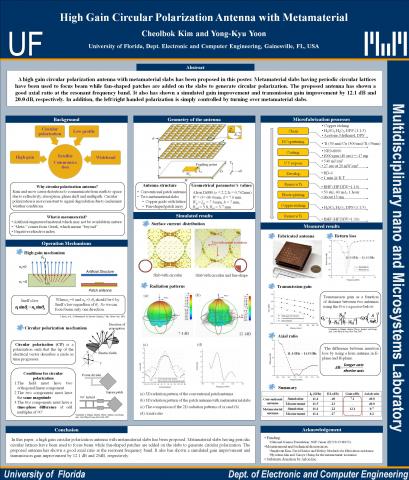
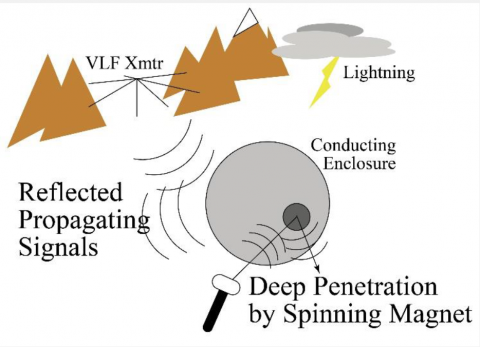
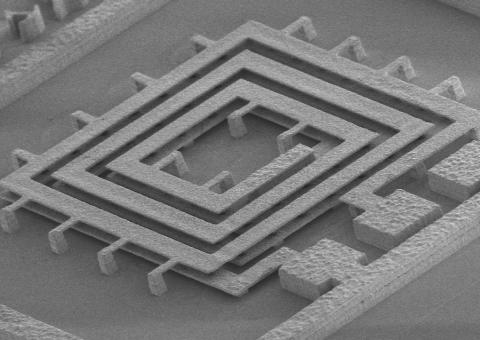
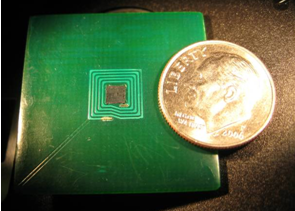
.png)
